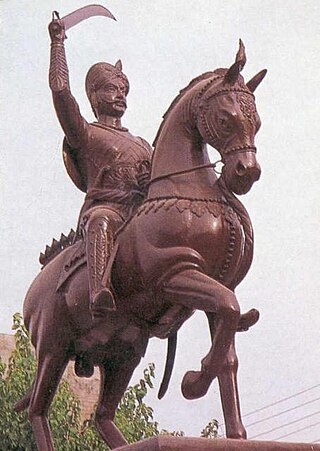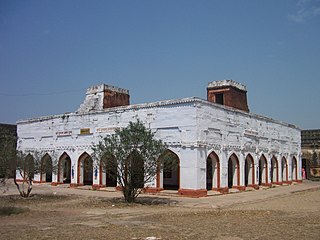Related Research Articles
Rajput, also called Thakur, is a large multi-component cluster of castes, kin bodies, and local groups, sharing social status and ideology of genealogical descent originating from the Indian subcontinent. The term Rajput covers various patrilineal clans historically associated with warriorhood: several clans claim Rajput status, although not all claims are universally accepted. According to modern scholars, almost all Rajput clans originated from peasant or pastoral communities.
Mahoba is a city in Mahoba District of the Indian state of Uttar Pradesh in the Bundelkhand region, well known for the ninth century granite Sun temple built in Pratihara style. It is also well known for the 24 rock-cut Jain tirthankara image on Gokhar hill. Mahoba is known for its closeness to Khajuraho, Lavkushnagar and other historic places like Kulpahar, Charkhari, Kalinjar, Orchha, and Jhansi. The town is connected with railways and state highways.

Prithviraja III, popularly known as Prithviraj Chauhan or Rai Pithora, was a king from the Chauhan (Chahamana) dynasty who ruled the territory of Sapadalaksha, with his capital at Ajmer in present-day Rajasthan. Ascending the throne as a minor in 1177 CE, Prithviraj inherited a kingdom which stretched from Thanesar in the north to Jahazpur (Mewar) in the south, which he aimed to expand by military actions against neighbouring kingdoms, most notably defeating the Chandelas.

The Chandelas of Jejakabhukti was an Indian dynasty in Central India. The Chandelas ruled much of the Bundelkhand region between the 9th and the 13th centuries. They belonged to the Chandel clan of the Rajputs.
The Meo are an ethnic group from the Mewat region of north-western India.
In Indian culture, the Agnivanshi are people who claim descent from Agni, the Vedic god of fire. The Agnivanshi lineage is one of the lineages among the Rajput clans, the others being the Suryavanshi and the Chandravanshi. According to medieval legends, there are four Agnivanshi clans: Chauhans (Chahamanas), Pratihar (Pratiharas), Parmars (Paramaras) and Solankis (Chaulukyas).

Mahoba district is a district of the Indian state of Uttar Pradesh. Headquartered in the city of Mahoba, the district had a population of a population of 875,958 as of the 2011 Indian census and occupies 2884 km2 within the Chitrakoot division of Uttar Pradesh. As of 2011 it was the least populous district of Uttar Pradesh. Mahoba District is also known as Alha-Udal Nagari.

The Prithviraj Raso is a Braj language epic poem about the life of Prithviraj Chauhan. It is attributed to Chand Bardai, who according to the text, was a court poet of the king.

The 'Bhavishya Purana' is one of the eighteen major works in the Purana genre of Hinduism, written in Sanskrit. The title Bhavishya means "future" and implies it is a work that contains prophecies regarding the future.
Rajput. The term Rajput covers various patrilineal clans historically associated with warriorhood: several clans claim Rajput status, although not all claims are universally accepted..
Banaphar, also spelled Banafar and Banafer, is a clan native to the Indian subcontinent of mixed Ahir and Rajput descent.

Udal is the name of a legendary 12th century general who appears in the Alha-Khand epic. In the epic, Udal and his brother Alha serve in the army of the Chandela king Paramardi Deva of Mahoba. They belonged to the Banaphar clan, which are of Rajput and Ahir descent.

The term Alha Khand is used to refer to poetic works in Hindi which consists of a number of ballads describing the brave acts of two 12th century Banaphar Ahir heroes, Alha and Udal, generals working for king Paramardi-Deva (Parmal) of Mahoba against Prithviraj Chauhan of Ajmer. The works has been entirely handed down by oral tradition and presently exists in many recensions, which differ from one another both in language and subject matter. The Bundeli, Bagheli, Awadhi, Bhojpuri, Maithili, and Kannauji recensions are the most well known among these.
The First Battle of Tarain, also spelt as the First Battle of Taraori, was fought in 1191 between the invading Ghurid army led by Muhammad of Ghor and the Rajput Confederacy led by Prithviraj Chauhan, near Tarain. The battle ended in decisive victory for the Rajputs; however, Muhammad of Ghor managed to escape and returned to Ghazni.
The Dahima is a Rajput clan in India. They are one of the 36 royal races of Rajputs. This clan is originated from Nagaur district of Rajasthan. Many of them worship Dadhimati Mata as their family goddess.
AJGAR was a suggested alliance of the Ahir, Jat, Gurjar and Rajput. It was first proposed by Sir Chhotu Ram, a rural leader and politician in pre-independence India as a form of peasant-alliance.
Chandel or Chandela is a Rajput clan from India. Families belonging to this clan ruled several kingdoms in north India and held various feudal estates. The most notable of these were the Chandelas of Jejakabhukti, who ruled the Bundelkhand region.

The Chahamanas of Shakambhari, colloquially known as the Chauhans of Sambhar or Chauhans of Ajmer, were an Indian dynasty that ruled parts of the present-day Rajasthan and neighbouring areas in India, between the 6th and 12th centuries. The territory ruled by them was known as Sapadalaksha. They were the most prominent ruling family of the Chahamana (Chauhan) Rajput clan.
Paramardi was a king of the Chandela dynasty of central India. He was the last powerful Chandela king, and ruled the Jejakabhukti region. Around 1182–83 CE, he was defeated by Prithviraj Chauhan, who raided the Chandela capital Mahoba. Paramardi managed to recover the Chandela power over the next few years, but was defeated by the Ghurid general Qutb ud-Din Aibak around 1202–03 CE.
Modern historians agree that Rajputs consisted of a mix of various different social groups and different varnas. Rajputisation explains the process by which such diverse communities coalesced into the Rajput community.
References
- Claus, Peter J.; Diamond, Sarah; Mills, Margaret Ann (2003). South Asian Folklore: An Encyclopedia : Afghanistan, Bangladesh, India, Nepal, Pakistan, Sri Lanka Special -Reference. Taylor & Francis. ISBN 978-0-415-93919-5.
- Crowley, Thomas (2020). Fractured Forest, Quartzite City A History of Delhi and Its Ridge. SAGE Publications. ISBN 9789353885564.
- Hiltebeitel, Alf (1999). Rethinking India's oral and classical epics: Draupadī among Rajputs, Muslims, and Dalits. University of Chicago Press. ISBN 9780226340500.
- Hiltebeitel, Alf (2009). When the Goddess was a Woman Mahābhārata Ethnographies : Essays. University of Chicago Press. ISBN 9789004193802.
- Mayaram, Shail (2022). The Secret Life of Another Indian Nationalism Transitions from the Pax Britannica to the Pax Americana. Cambridge University Press. ISBN 9781108832571.
- Talbot, Cynthia (2016). The Last Hindu Emperor: Prithviraj Cauhan and the Indian Past, 1200–2000. Cambridge University Press. p. 203. ISBN 9781107118560.